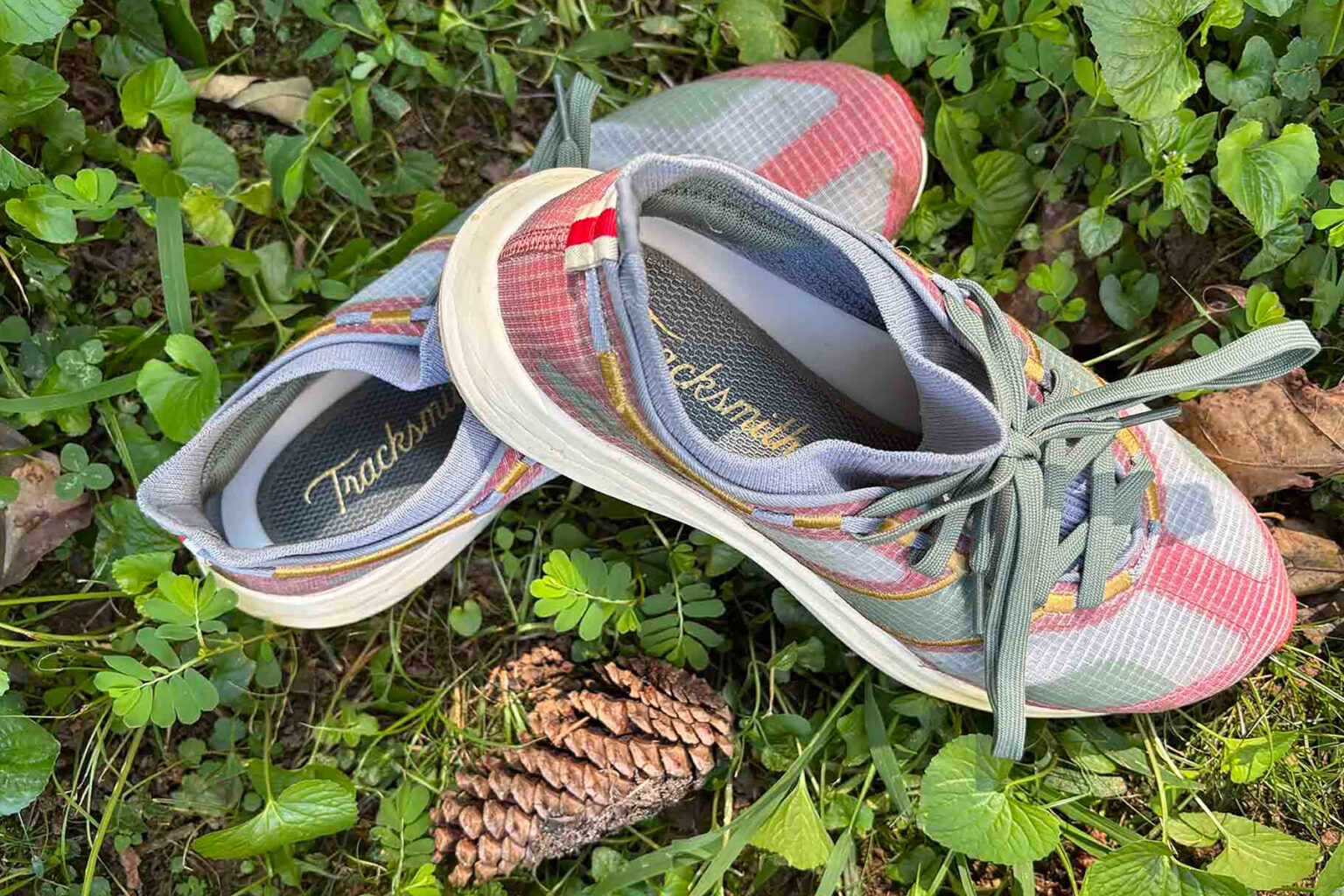What if we didn’t make a trail shoe aimed at the Rocky Mountains? That seems to be the approach taken by New England brand Tracksmith with its latest release.
Most of the popular trail runners follow HOKA and Altra’s schools of thought: maximum cushion and a roomy toe box. And I can attest, those shoes perform brilliantly. But unless you’re regularly running long days on intensely rocky trails, they’re also more than most of us need.
It’s true of any sport: The best thing for elite athletes is rarely the best thing for the average user.
That’s precisely what Tracksmith considered when designing the Eliot Range, a trail running follow-up to its well-received Eliot Runner road shoe. GearJunkie reviewer Cory Smith lauded the Runner as “one of the highest-quality running shoes I’ve tested.” After running about 50 miles in these shoes through various trails and state parks in the Atlanta area over the last few weeks, I can confidently echo that sentiment about the Eliot Range.
These shoes fit my personal style and tastes so well that they make me want to get out and run even more.
In short: While not everyone may like the merino wool bootie, medium cushioning, and large heel drop (9mm), these departures from other trail shoes lent my runs agility and precision. The Eliot Range allowed me to feel the terrain under my feet, while still providing a power boost from the supercritical top-layer foam and injected nylon plate. The shoe could still use a few upgrades — like a toe bumper and more traction — but for anything other than highly technical, all-day trail runs, these functional (and fashionable) kicks are hard to beat.
-
Agile and precise -
High energy return -
Great ground feel -
Lightweight -
Stylish
-
Very expensive -
Lacks toe protection -
Specific to narrow feet
Tracksmith Eliot Range: Review
As a recent transplant to the southeastern U.S., I have to admit that I often miss the endless mountain trails of Colorado. I’m a climber and hiker, so I’m always in search of sharp elevation changes, which the Appalachians simply can’t provide to the same degree.
There’s still plenty of joy to be found in the forests, rivers, and mountains of Georgia, Tennessee, and North Carolina, if not the technical levels of the Rockies. I can find decent elevation changes, enough rocks and roots to keep things interesting, and still have a beautiful forest or river to keep me company.
It’s a solid context for experiencing the Eliot Range, which is unapologetically engineered for New England terrain. Tracksmith explicitly bills its apparel and shoes as inspired by the region’s less technical trails and distinct running culture.
I wouldn’t use the Eliot Range on an all-day adventure on the Benton MacKaye trail, arguably Georgia’s most difficult trail. But for nearly anything else along the Chattahoochee or Stone Mountain, I’ve been happily reaching for Tracksmith’s comfy runners.
First Impression: Perfect for Narrow Feet
I can’t deny that I loved these shoes from the very first moment I put them on. The merino wool bootie, along with the shoe’s narrow fit, makes my feet nice and snug, even without tying them up.
Wider-footed runners will want to steer clear of the Eliot Range. But for a slim-footed fellow like myself, this shoe design is like the first time I wore a slim-fit, button-up shirt: Why didn’t I try this sooner?
I also love a shoe that slips on and off with minimal effort. It’s tough to balance that with a style of shoe meant to stay snug while getting pounded by rocks, but the Eliot Range finds an admirable middle ground. Again, not everyone will love the extra-low ankle cuff, but I’m a big fan of that flexibility in a trail shoe. And despite the low cuff height, internal side pads kept my heel planted and secure.
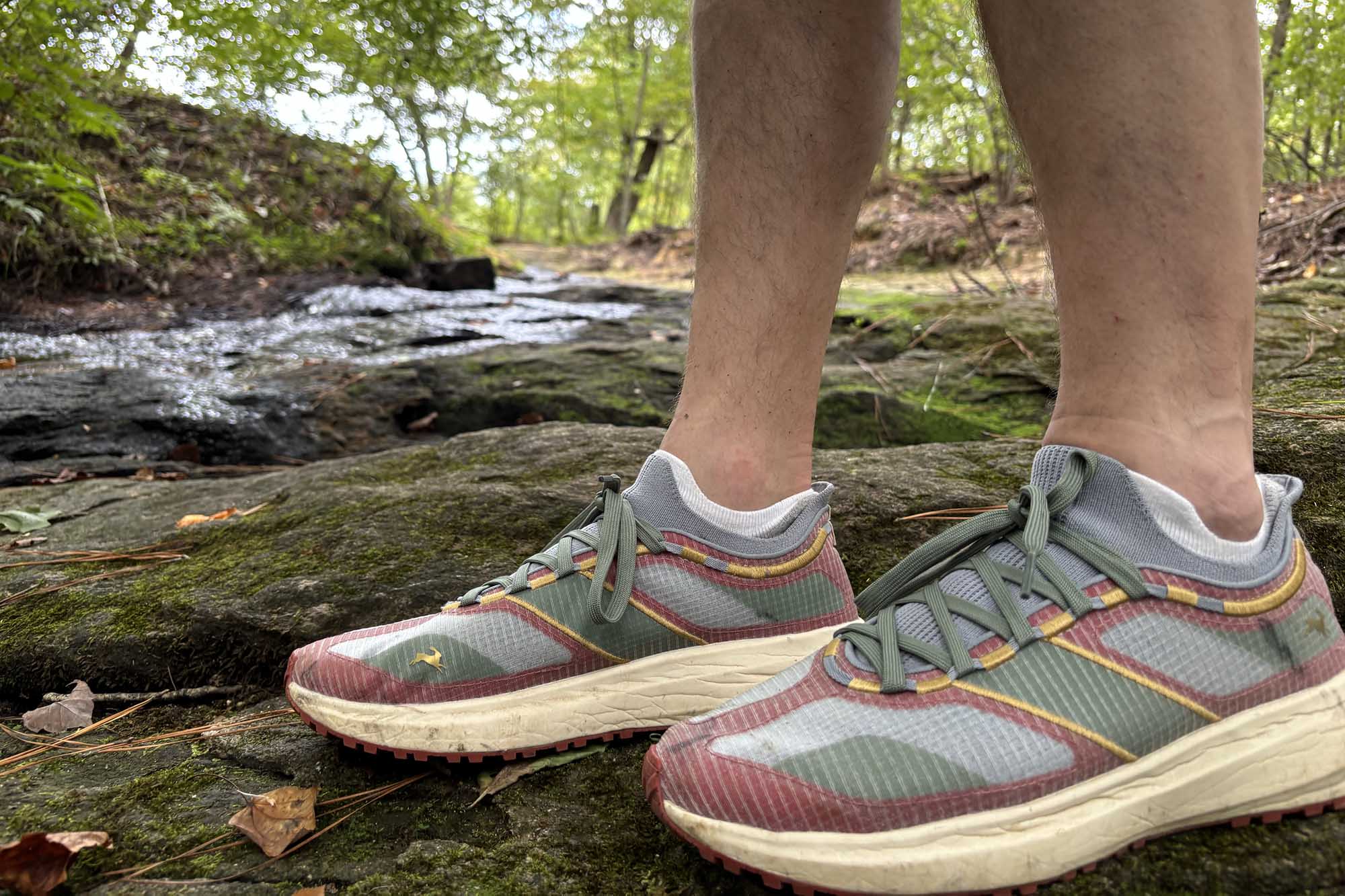
Trail Testing Against the Elements
Despite its comfy slip-on status, you’ll want to tie these puppies up nice and snug before hitting the trail. The flexible, merino wool bootie wraps around the foot like an extra sock — but your feet won’t be secure during running unless these are laced up tightly.
As for the rest of the upper, it’s a woven mesh shell that does a decent job of keeping out moisture. (But it’s still just water resistant — not waterproof.) My feet stayed dry when using the Eliot Range on wet, muddy trails, but these won’t hold up against prolonged rain.
Despite the thinner midsole compared to HOKA shoes, the Eliot Range’s injected nylon plate and the midsole’s lightweight but bouncy foam allow for loads of energy return. The shoe’s midsole also includes Pebax, a super-lightweight polymer increasingly used in “super shoes” to reduce fatigue.
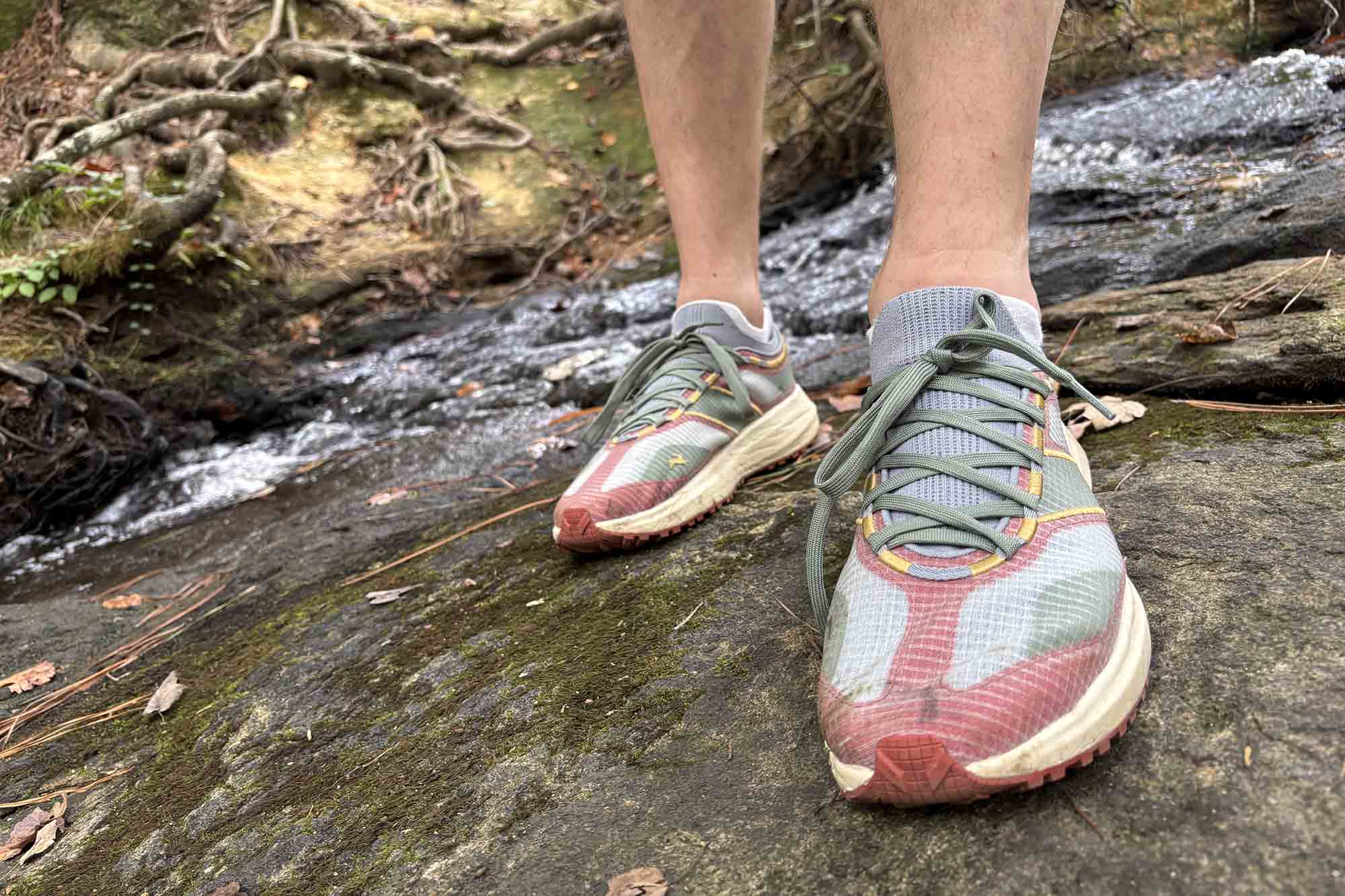
Moreover, the Vibram outsole offers solid grip on the slick granite of Atlanta’s short mountain hikes. But it didn’t hold up quite as well when that rock became slippery wet. That being said, even my highly technical Speedland PDX will sometimes slip on those rocks, proving that no outsole can prevent falls once the rain starts falling hard enough on smooth rock.
But let’s be real: How often do most of us run in the rain on slippery rocks? Not often. The Eliot Range frequently brought me to a flow state in my running, be it loose gravel, concrete roads, wooden boardwalks, or root-covered river trails.
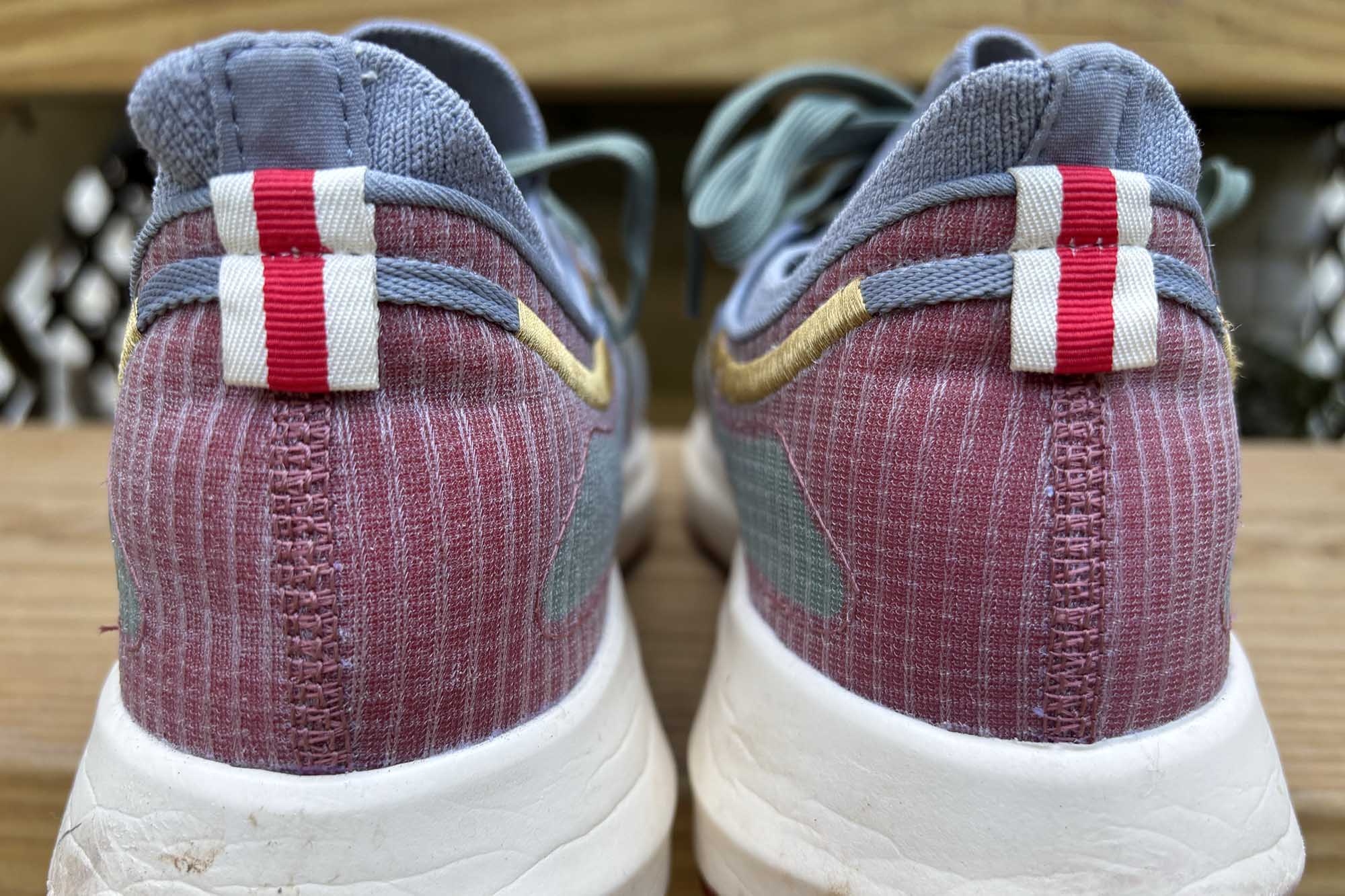
Equal Parts Fashion and Function
Let’s also talk about the elegant elephant in the room: These are some classy-looking kicks. The blend of muted colors, golden Tracksmith bunny logos, and golden trim accents. The Eliot Range will clearly appeal to running sophisticates. Once again, it’s a departure from the tie-dye color blasts of HOKA or the bright color schemes of Altra.
I’ll admit that the Eliot Range looked almost too fashionable to me, when I first got the email from Tracksmith. But I can happily report that the chic appearance reflects the brand’s commitment to quality at every level — not simply a gorgeous paint job on a disappointing design.

Notable Downsides
For all their endearing qualities, Tracksmith has some room to improve with these shoes. For starters, adding a wider-foot option to the design would likely attract more runners.
Also, the lack of any additional foot protection on the upper, especially for the toes, will deter many trail runners. That’s not a big deal for me, as I don’t find myself taking many falls. But if you’re prone to stubbed toes, you’ll probably want to wait for the (hopefully inevitable) upgrade to make these a little more mountain-hardy.
Finally, they are pretty dang expensive. At an eye-watering $240, these kicks are even pricier than adidas Terrex’s “trail super shoe,” the $220 Agravic Speed Ultra.
Much of the price tag can likely be attributed to the nylon plate and merino wool upper. In any case, the cost faithfully represents (in my opinion) a dedication to quality materials and design — but that doesn’t make them a necessary purchase.
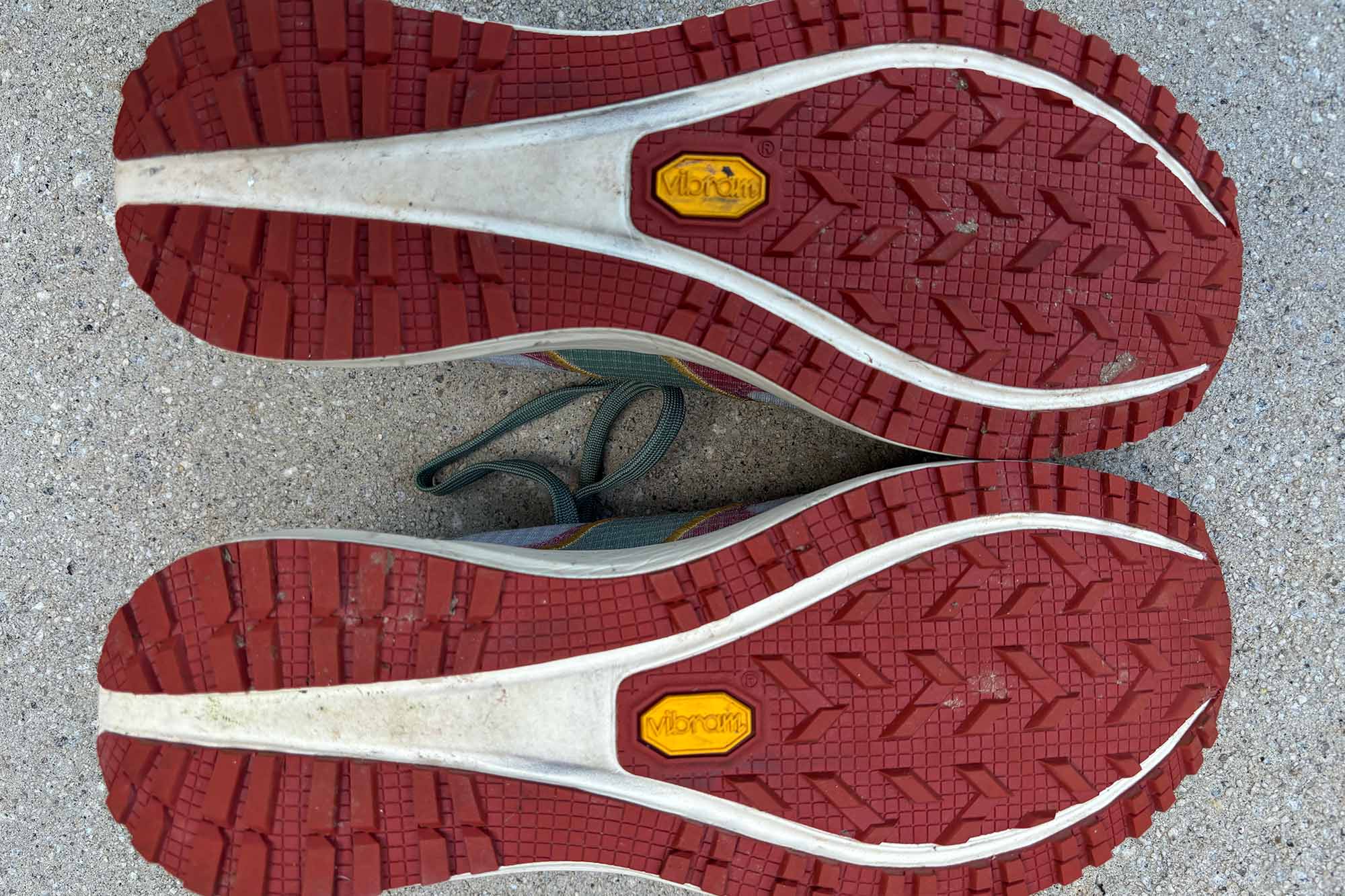
Final Verdict: Who’s It For
Many trail runners will likely scoff at the Eliot Range’s high price, thin upper, and lack of toe protection. But if you have a chance to try them on and take them for a test run, I think you’ll be pleasantly surprised at just how great they feel.
If you don’t like them? Tracksmith will still refund the shoes within 100 miles or 30 days of purchase.
Though it’s hard for a casual runner to justify the investment, I’m in love with these shoes — even while humping a 25-pound photography backpack up a mountain, they feel amazing. Where a pair of HOKAs make me feel like a bulldozer, these shoes make me feel like a motorbike: I’m fast, agile, and precise, while still feeling the ground beneath my feet.
As an unfussy trail runner squeezing in runs whenever I can, these have become my favorite shoes for most trails.
Read the full article here



